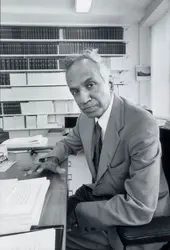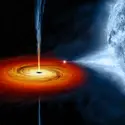CHANDRASEKHAR SUBRAHMANYAN (1910-1995)
Article modifié le
Bibliographie
Écrits et articles principaux
S. Chandrasekhar, « The Highly Collapsed Configurations of a stellar mass », in Monthly Notices of the Royal Astronomical Society, vol. 91, pp. 456-466, 1931 ; « The Maximum Mass of ideal white dwarfs », in The Astrophysical Journal, vol. 74, pp. 81-82, 1931 ; « The Physical State of matter in the interior of stars », in Observatory, vol. 57, pp. 93-99, 1934 ; « The Highly Collapsed Configurations of a stellar mass », in Monthly Notices of the Royal Astronomical Society, vol. 95, pp. 207-225, 1935 ; « Stellar Configurations with degenerate cores », in Monthly Notices of the Royal Astronomical Society, vol. 95, pp. 226-260, 1935 ; An Introduction to the Study of Stellar Structure, University of Chicago Press, Chicago, 1939, rééd. Dover, New York, 1957 ; Principles of Stellar Dynamics, University of Chicago Press, 1942, rééd. Dover, 2005 ; Radiative Transfer, Clarendon Press, Oxford, 1950, rééd. Dover, 1960 ; Hydrodynamic and HydromagneticStability, Clarendon Press, 1961, rééd. Dover, 1981 ; « The Dynamical Instability of gaseous masses approaching the Schwarzschild limit in general relativity », in The Astrophysical Journal, vol. 140, pp. 417-433, 1964 ; The Mathematical Theory of Black Holes, Clarendon Press, 1983, rééd. Oxford University Press, New York, 1992 ; Eddington. The Most DistinguishedAstrophysicist of his Time, Cambridge Univ. Press, Cambridge (G.-B.), 1984 ; Truth and Beauty. Aesthetics and Motivations in Science, University of Chicago Press, 1987 ; Selected Papers, 6 vol., University of Chicago Press, 1989-1991.
Études
A. I. Miller, Empire of the Stars : Obsession, Friendship, And Betrayal In The Quest For Black Holes, Houghton Mifflin, Boston, 2005
K. C. Wali, Chandra : A Biography of S. Chandrasekhar, University of Chicago Press, 1991
K. C. Wali dir., S. Chandrasekhar, The Man Behind the Legend, Imperial College Press, Londres, 1997 ; A Quest for Perspectives : Selected Works of S. Chandrasekhar, ibid., 2001.
La suite de cet article est accessible aux abonnés
- Des contenus variés, complets et fiables
- Accessible sur tous les écrans
- Pas de publicité
Déjà abonné ? Se connecter
Écrit par
- Bernard PIRE : directeur de recherche émérite au CNRS, centre de physique théorique de l'École polytechnique, Palaiseau
Classification
Média
Autres références
-
GRAVITATION ET ASTROPHYSIQUE
- Écrit par Brandon CARTER
- 8 923 mots
- 4 médias
...supérieures à la valeur caractéristique donnée en (20) (déduction confirmée ultérieurement par les travaux plus détaillés de M. Schwarzschild et d'autres), Subrahmanyan Chandrasekhar obtint en 1931 un résultat encore plus remarquable en montrant qu'à la fin de sa vie active (après épuisement de toutes les... -
TROUS NOIRS
- Écrit par Jean-Pierre LUMINET
- 12 850 mots
- 13 médias
...(1911-2008), qui en 1968 a donné le nom de « trous noirs » à ces astres (auparavant appelés astres invisibles ou occlus, étoiles gelées, cercles magiques…) ; le Prix Nobel de physique 1983 Subrahmanyan Chandrasekhar (1910-1995) et celui de 2020 Roger Penrose (né en 1931) ; l’Italien Remo Ruffini (né en 1942) ;... -
UNIVERS
- Écrit par Jean AUDOUZE et James LEQUEUX
- 6 652 mots
- 18 médias
...ou II. Les parties centrales des supernovae subsistent non pas sous forme de naines blanches mais d'étoiles à neutrons (ou pulsars). Comme l'a montré Subrahmanyan Chandrasekhar, lorsque la masse de l'étoile résiduelle dépasse une limite égale à 1,44 masse solaire, l'étoile devient une étoile à neutrons...
Voir aussi




